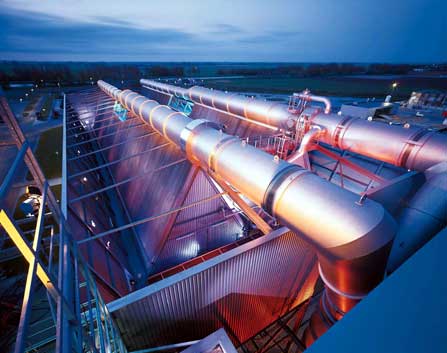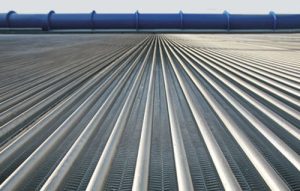Air Cooled Condenser


The Air Cooled Condenser belongs to the dry cooling systems. In direct dry cooling, steam from the steam turbine passes through air-cooled fin tubes. The condensate is not in contact with the cooling air.
Steam from the turbine is discharged into a steam duct and flows to a fin tube bundle in which it is condensed. The A-frame tube bundle is mounted on a platform carried by a steel or concrete structure. Fans integrated in the platform structure below the fin-tube bundle draw ambient air and discharge it along the fin tubing for cooling. The cooling air absorbs the heat of condensation from the steam. The hot air leaves the facility along the outside surface of the fin tube bundle.
ALEX-SYSTEM: ALUMINIUM FIN STEEL TUBE SYSTEM

Construction and form:
The ALEX system consists of an aluminium coated steel flat duct. Aluminium finnings between the flat ducts are hard-soldered to the aluminium coating of the flat duct. The solder fills the gap between the fin root and the core tube completely to achieve excellent heat transfer properties.
The advantages of the ALEX-System are:
- The weight of an aluminum fin tube bundle is no more than one third of the weight of an equivalent galvanized steel fin tube bundle. The outcome is a reduction of weight in steel construction.
- The ALEX-System is our premium product in heat transfer.
- Optimal use of the complete cooling surface as no-flow regions are avoided.
- The fin tubes are not sensitive to fouling and, if necessary, easily cleaned with high-pressure water or compressed air.
- A life span of over 25 years confirmed by corrosion tests.
A-TUBE MULTIPLE ROW SYSTEMS

Construction and form:
The A-tube consists of an elliptical core tube with rectangular steel finning. Heat transfer is optimized by hot dip galvanization. The gap between the fin root and the core tube is filled completely by zinc.
Advantages of the A-tube system are:
- It has a very long life span of over 30 years.
- The steel fins are not sensitive to typical mechanical loads, for example hailstorm or walking on the bundles.
- Hot dip galvanization provides corrosion protection.
No-flow regions are avoided by different first and second row fin pitch.
MASH© MULTIPLE ROW SYSTEMS

Construction and Frame
The prime design for Vacuum Air-cooled Condensers is based on MASH© concept. Steam is brought to the condenser via steam duct and a manifold. Steam flows down across 2 or 3 rows of finned tubes. Condensates are recovered inside bonnet header boxers connected to a hot water tank. Non condensable goes up through a deflegmation row for final condensation.
Advantages of the MASH system are:
- Frames of tube bundles and supporting A frame structure designed for Modular assembly concept and transportation by sea requirements
- Over 30 years corrosion resistance using Extruded fins technology.
- Answering most of API 661 (ISO 13706) and ASME VIII div 1 requirements
- U stamped when required by end user
- Round tubes of 2,11 mm core thickness
Optimized selection for plot plan restrictions using Groovy fins.
IN-AIR

From the company who invented the Air Cooled Condenser, comes the next generation of innovative and intelligent design: The InAIR blends proven components and technologies to yield the next generation in dry cooling: an Air Cooled con-denser featuring induced draft fans.Induced draft fans have been used reliably in the majority of power plant main cooling systems, world-wide (e.g., wet cooling towers, indirect dry cooled Heller systems), but their application in ACCs have been limited due to higher costs.
But through innovative engineering and utilization of our self-supporting ALEX bundles, ENEXIO can now offer the InAIr, an ACC which offers the superior operational per-formance of ID fans with added savings in material supply, delivery durations, and construction effort.
Primary benefits over classic ACC with forced draft fans:
- Reduced air inlet and total height of ACC: less visual impact
- Smaller footprint of columns
- Reduction of steel structure quantities (-60 %)
- Reduction of steel structure weight (-50 %)
- Reduced costs for construction (-10 % to -25 %)
- Reduced construction duration: 20 % to 30 % decrease in man-hours for erection work
- Easier pre-assembly (mainly pre-assembly on ground)
- Inherent design of supporting steel structure greatly reduces the requirement of scaffolding
- Reduction in the length of the main steam duct
- Reduced investment costs
- Shorter delivery and erection periods
No fan bridge needed In a classic forced draft ACC, the fans are exposed to an elevated level of dynamic loading. The vibrational effect of dynamic loading can be mitigated by calculation and design – but not eliminated. The InAIr resolves this weakness in the classic ACC design.
Operational advantages
- InAir requires no fan bridge, resulting in less vibration stress which leads to longer lifetime of rotating equipment
- Less sensitivity to wind effects
- Minimized air recirculation due to high exit velocities of air
- Reduced auxiliary power demand due to lower air-side pressure drop
